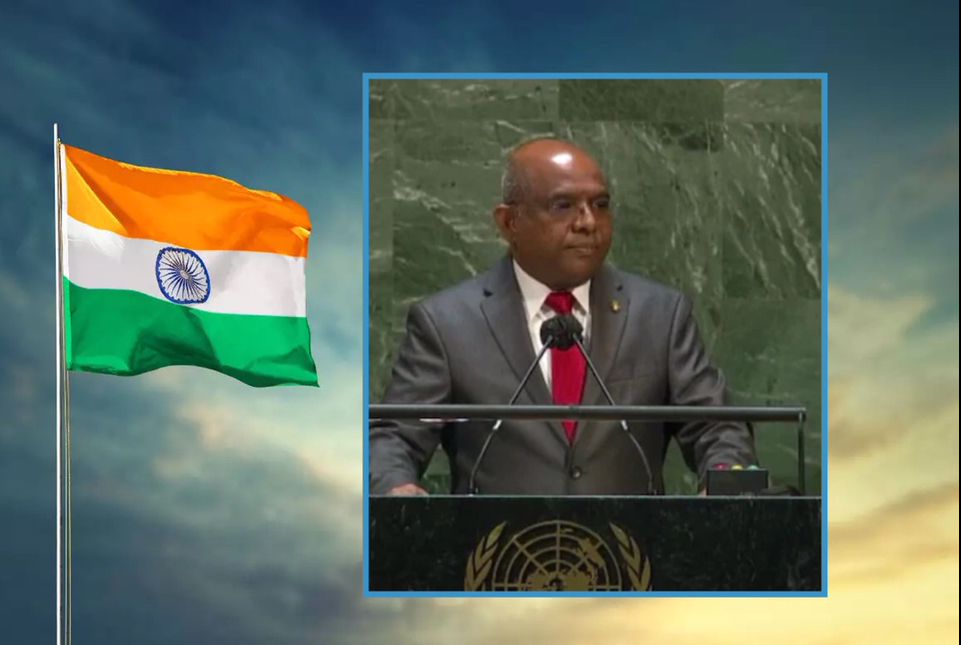Colombo, June 11: India has enlarged its footprint in the Maldives with three recent steps: It is believed to have been the primary force behind the election of the Maldivian Foreign Minister Abdulla Shahidas President of the 76 th., session of the UN General Assembly. It got Shahid to accept IFS officer Kakanur Nagaraj Naidu as his Chef de Cabinet. It unilaterally announcedthat it will be establishing a Consulate in the strategically important South Maldivian Atoll of Addu.
However, the Maldivian President Ibrahim Solih has said that no decision has been taken on opening the Consulate in Addu. Solih’s hesitancy is perhaps due to opposition to the Indian project from a section of Maldivians expressing themselves through the hastag#SaveAddu. Or Solih is himself miffed by New Delhi’s unilateral announcement.
Be that as it may, the Consulate is expected to be set up eventually, because President Solih would be hard put to it to disregard India, given the latter’s growing financial hold on his government. India has pumped in a lot of money to execute projects in, and strengthen the finances of, the Maldives. The aim has been to counter China, which had complete control over the previous government led by Abdulla Yameen.
India’s Economic Footprint
India has expanded its economic footprint in the Maldives since Solih came to power winning the 2018 Presidential election. According to the Maldives Financial Review (MFR) India has pledged substantial amounts of investment in developing a cancer hospital, multiple residential housing projects and a cricket stadium, among others. These lines of credit are essentially loans as well, and figures show that India is providing over USD3 billion to the country through various channels, the MFR says.
It further says that India is working on military-like collaborations. Two helicopters have been gifted to the MNDF by the Indian military, along with servicemen to operate them, which have been admittedly as yet utilized more for humanitarian needs than for any military objectives. Further, the Maldives and India have agreed to establish an Indian-operated radar system in the archipelago in an attempt to tighten surveillance of the Indian Ocean Region. There is an Indian funded Police Training Institute in Addu.
“More recently, the Indian government has pledged to build a dockyard facility in the Maldives, officially describing it to be run and utilized by the MNDF Coast Guard as a maintenance and staging area,” the MFR added.
Two Views on Consulate
Supporters of the Indian plan to open a Consulate in Addu City say that it will obviate the need for people from the second largest city in the Maldives to travel 535km by air to capital Male to get their visas to go to India for study and medical treatment. According to The Hindu even after the pandemic struck, at least 8,000 visas were issued to Maldivians on medical and educational grounds.
But the opposition thinks that the Consulate in Addu would eventually lead to the establishment of an Indian military base following the example set by the British in World War II. A social media campaign under the hashtag #SaveAddu is currently being waged against this plan.
Strategic Value of Addu
There are reasons to believe that the real reason for New Delhi’s interest in Addu is not issuing visas but strategic. According to the Indian Ministry of External Affairs website, the Maldives’ proximity to the west coast of India (it is barely 70 nautical miles away from Minicoy and 300 nautical miles away from India’s West coast), and its situation at the hub of commercial sea?lanes running through Indian Ocean (particularly the 8° N and 1 ½° N channels) imbues it with significant strategic importance to India.
The Addu Atoll, especially Gan island, is strategically located in the Indian Ocean. This fact made the British establish an air and naval base there before World War II broke out East of Suez.
The Maldives became an essential link in the allied defenses against the Japanese in the Indian Ocean. According to Jonathan Kearney, the Addu Atoll, the southernmost atoll in the Maldives, became the Royal Navy and Royal Air Forces’ most important strategic outpost in the Indian Ocean.
Exploiting their suzerainty over the Maldives, the British secretly built a base in Addu in 1941. According to Kearney, Ganisland in the Atoll was completely cleared of vegetation to make way for a runway. Its villagers were relocated. A base for sea-planes was built at Hithadhoo lagoon, where planes flew in from as far away as Singapore and Sri Lanka. Underground bunkers for supplies and bombs were constructed at Maradhoo. A series of causeways were constructed between the main islands, Kearney wrote in 2020.
“RAF Gan was a busy and important base. It covered one of the largest aerial search areas in the world and handled thousands of aircraft and passengers during its operation,” he added.
At that time, the enemy was never far away from Addu. German U boats patrolled the waters. In March 1944 the German submarine U-183 fired through the Ganchannel, torpedoing the oil tanker British Loyalty that was anchored in Addulagoon.”
Interestingly, the men who served and died in the Addu Atoll were predominately Indian, members of Indian regiments who were stationed there soon after the base was constructed.
Post War Developments
Continuing Kearney says: “When World War II ended, the RAF wanted to hold onto this strategic position at Addu, building a new airbase at Gan and a radio-communications center at Hithadhoo in 1957. It was an ideal re-fuelling and supply post on the route linking the UK to Hong Kong, Singapore, Australia and the rest of East Asia.”
A lease was granted to the British to occupy the Addu Atoll Gan island for 30 years, an agreement that was upheld after the Maldives gained independence in 1965. But the British withdrew from Addu in 1976, before the lease expired, Kearney recalls.
Maldivian Government’s Offer
In 1976, the Maldives government invited “offers or proposals from those interested in leasing the island of Gan and facilities for any purpose considerered reasonable”. The facilities mentioned included an international-standard runway 2.6 km. long, a 2.5 megawatt diesel power-generating plant, modern airfield aids including radar, and a medical center “capable of dealing with air crash victims if the necessity arises”.
But Maldives did not want Addu to be used a military base. It’s then Deputy head of the Department of External Affairs, FathullaJameel, was quoted as saying: “We joined the non– aligned movement last month and attended the summit conference in Sri Lanka. So now it should be doubly clear that Gan is not for rent as a military base”.
Secessionist Movement
A worrying aspect for present-day Maldivians is that the Addu Atoll had a secessionist “Suvadives” movementbetween 1959 and 1963 backed by the British. It was put down by military forceby the then government at Male. The secessionist leader, Abdulla Afeef, fled to the then-British colony of Seychelles, where he was granted political asylum. The British left the Maldives soon after in 1965, giving full independence to the Maldives.
With the growth of China’s power now and the building up a counterbalancing alliance between India, USA, Japan, and Australiaknown as “Quad”, the Maldives has again become attractive to competing world and regional powers seeking exclusive strategic advantage at the Western end of the Indian Ocean.
END





